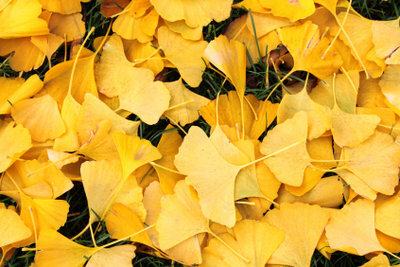Planting ginkgo in the garden
A ginkgo does not make any special demands on the garden. The name "Ginkgo" is not only known in Asian medicinal medicine, the Ginkgo and others are also used in this country. a. used as a remedy. Since the ginkgo can adapt well to a wide variety of environmental influences, it is preferred to be planted in heavily polluted cities.

Ways to plant a ginkgo
- A ginkgo is very versatile. It can be cultivated both as a container plant and directly in the garden. For planting in pots, ginkgos are now available in differently cut shapes. With a little winter protection z. B. from straw, the plant can overwinter in a sheltered place in the garden. You can purchase a ginkgo in nurseries both as a four to six year old young plant and in the form of a two year old sprout.
- You can transplant young ginkgo trees into the garden in spring and autumn. The location can be sunny or partially shaded. For planting, you should dig the planting hole four to five times as large as the size of the root ball. It is best to mix the earth with a third compost. Finally, water well. You can fertilize it every 2 weeks with a cap of universal fertilizer (half concentration) that you add to the plant with the irrigation water. Ginkgo seedlings, which are known as bonsai can cultivate. It is important to ensure that the substrate never dries out.
- If you want to try growing ginkgo from seeds yourself, it is advisable to get a male one Planting the ginkgo tree, as the fruits of the female trees have a very unpleasant butyric acid odor spread. Corresponding seeds can be obtained from specialist retailers. Sowing should be carried out in April / May. The nuts are put into a seed pot approx. 2 cm deep into the substrate, which should consist of a peat-sand mixture. You should now keep the whole thing warm and moist until germination. You can separate the seedlings in autumn. The individual seedlings can vary greatly in their external appearance.
- The problem with sowing is that it can take more than 2 years to germinate and the cuttings very much are sensitive to transplanting, so that only about a third of them grows, which in turn is very high takes long.
- The small-stature "Mariken" variety is very suitable for smaller gardens. It is a dwarf form of the ginkgo and reaches a height of 2 meters and a width of 2 to 3 meters. With its fan-shaped leaves, which turn golden yellow in autumn, the small bonsai is a decorative eye-catcher in every garden.
Ginkgo Biloba - how to care for the tree from China
Ginkgo biloba - although this strange fan-leaf tree has been around for over 250 million years ...
How to care for the Asian plant in the garden
- Young ginkgo trees require a little more maintenance than older ones in the first 2 to 3 years. They need to be protected from blazing sun, drought and frost. Twigs of fir or spruce trees are suitable as frost protection, as they allow sufficient air and light to reach the plant and still protect it from frost. Older trees no longer need winter protection.
- A young ginkgo should be provided with a support pole in the first few years, as it tends to warp at first. In very warm temperatures it has to be sufficiently watered as its roots are not yet deep enough to provide itself with sufficient water. Up to the age of four you should overwinter a ginkgo in a cool, but frost-free place, only then can it survive the winters outdoors without damage. A disease or pest infestation is not to be feared with this impressive plant.
- A somewhat older, stronger tree prefers a location in full sun to partial shade. The ideal soil is a well-drained, moist, sandy, well-drained clay soil. A ginkgo from a height of 6 meters no longer needs any maintenance. It doesn't have to be poured or fertilized, but it doesn't hurt if he gets some universal fertilizer every now and then.
How helpful do you find this article?
